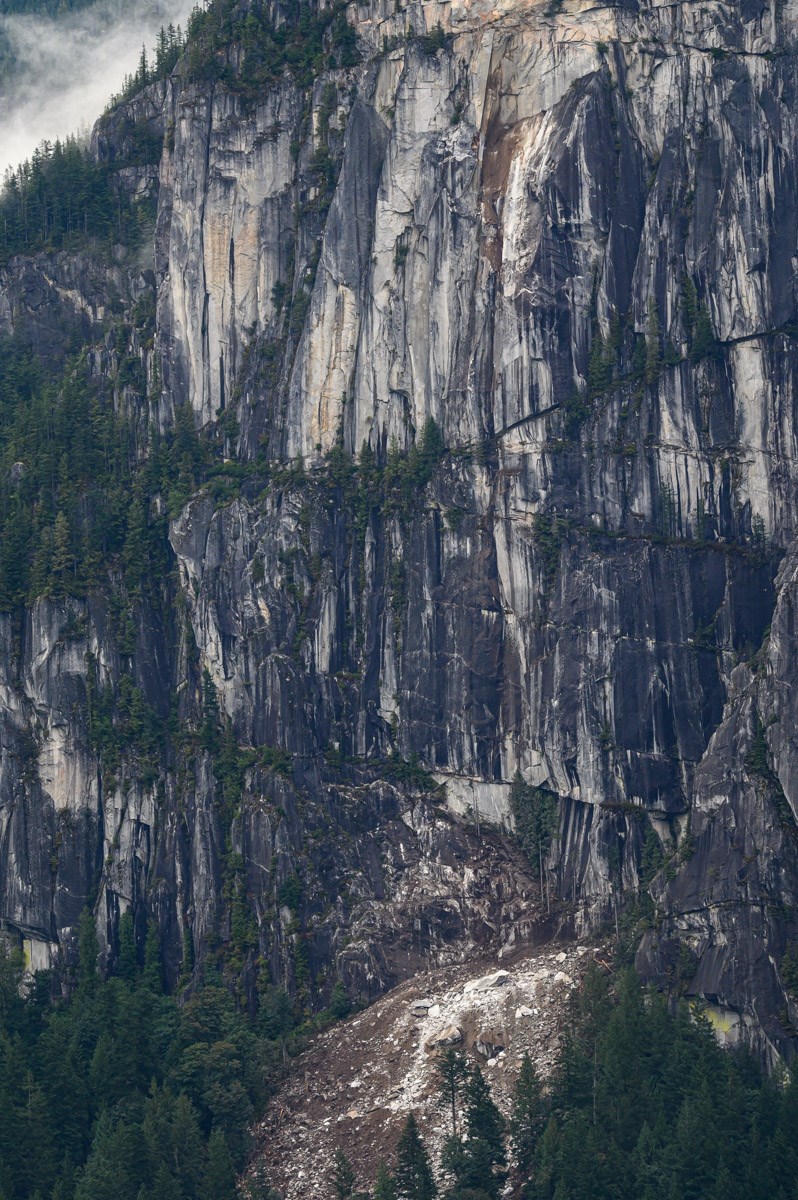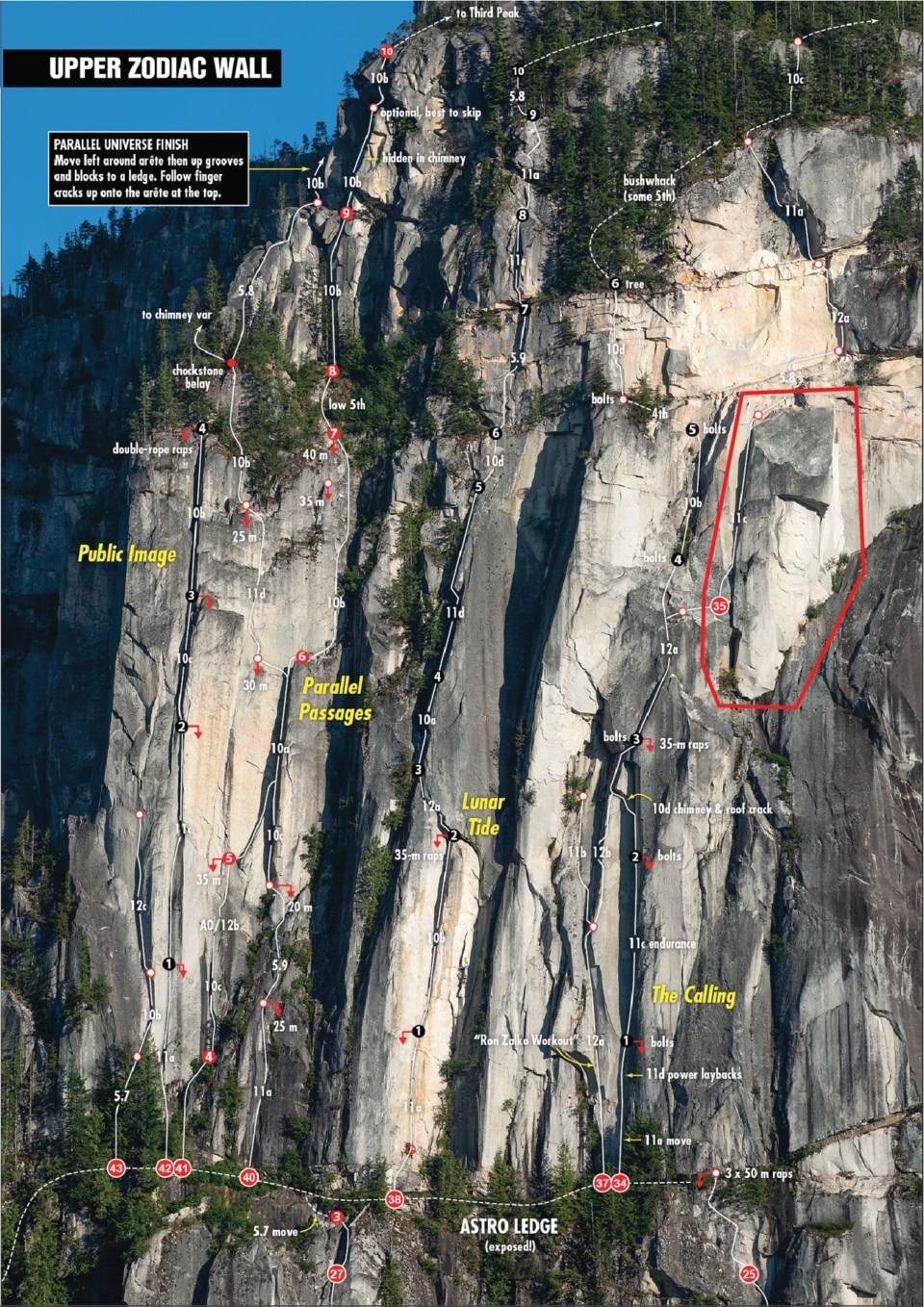Video by Alexis Birkill
Anne Bright awoke at around 1:34 a.m. on Sept. 20 to what she thought was thunder.
Then she felt the entirety of her downtown Squamish home in Eaglewind shake, and realized this was not a routine rainstorm. The window panes were rattling, reverberating with the sound.
"It was the loudest crash — it sounds almost like a train shunting, and then you hear repetitive things afterward," Bright told The Chief.
"There were a couple of loud crashes [afterwards] — not as loud as the first one — and then afterward you could just hear rumbling."When she went outside and saw her neighbours in Rockcliff looking at the Stawamus Chief, she realized that for the fourth time, a major rockfall had occurred on the monolith. Including a fall on Slhanay, this marks the fifth major rockfall event in Squamish this year.

Alexis Birkill, who operates , caught the incident on tape. The footage shows a massive slide plummeting down from the Upper Zodiac Wall of the Stawamus Chief. As the rocks collide with each other and the monolith's face, sparks are kicked up, lighting up the night. A plume of dust lingers in the area and drifts towards the highway.
In Valleycliffe, Ivan De Wolf was having a similar experience as Bright.
"I knew it was a rockfall, but I didn't know if it was coming towards the house. It sounded big and it sounded like it was getting bigger," said De Wolf.
"In the middle, it kind of had a bass rumble to it. The house shook. The windows rattled in their frame...it ran for a good bit of time."
Not far from De Wolf was another Valleycliffe resident, Laura Modray.
"It just kept getting louder, and louder," said Modray.
"I was standing in my yard in my bare feet and I was like, 'Oh my God.' And I could feel it coming in the ground. I could feel the ground moving. And then I just had my hand over my heart going, 'Oh my goodness, this is bad.'"
Indeed, the ground was literally moving.
Seismic readings from the Incorporated Research Institutions for Seismology show that a station at Watts Point registered the earth-shaking event.
The chart shows a hefty spike at the time of the rockfall, showing the incident was large enough to make the ground tremble.
There was no actual earthquake, however, as did not register such an event.
The people who felt and heard the fall say that noise persisted beyond the initial crash. Bright said she heard sounds coming from the Chief for about 20 minutes.
Steve Quane, the head geologist at the, said that it's plausible for the rumbling to have continued for some time.
There's an initial big slide, then smaller pieces of rock fall off in the time afterwards, he said. The rocks also take time to settle and that creates noise. More boulders can spill off and start ping-ponging against the trees, leading to more rumbling.
Quane said that the most likely cause of the event was the recent rainfall coupled with the extreme heat that occurred this summer.
The heatwave likely caused the rock to expand during hot cycles and contract in cooler temperatures. This would create stress fractures.
On top of that, a recent deluge of rain would be the final trigger that set the fall in motion.
"You can think of rain getting in there and lubricating the cracks. A lot of times, the cracks are pre-existing weaknesses where the rock might be broken down a little anyway," said Quane.
"When you add water to anything, it increases the weight. So If you have soils in there that increase the weight, that could pry the rocks off."
Quane added that this is happening more often now, most likely as a result of climate change.
Gio Roberti, climate risk section head at , gave a similar assessment.
"The water goes into the fracture and kind of pushes the rock away from one another. So you can imagine putting a lot of water in a crack and the water pressure will push the crack more, opening until eventually, the pillar comes off," said Roberti.
"You can imagine thinking if you have a sandcastle and you add too much water, the water pushes the grains away from one another, and the castle collapses."
Roberti, who has climbed in that general area, warned against going there.
"I wouldn't climb anything on the main wall there. There was a rockfall in 2015. The area is very active with lots of unstable rocks," he said.
"For people who want to go climb around there, the best way is to stick to ridges and not go on those open faces. And another way to evaluate risk, is if at the base of the cliff there's no forest, just rocks — that means it's an active rock face so you don't want to be there. If you see big trees, that means there were no major rockfall in the lifespan of the tree, and so you can say, 'OK, maybe I can take the risk.' But anywhere that there's fresh activity, people need to stay out."
He said people tend to think of mountains as a static thing, but they are a very dynamic environment.
"We need to put aside the ego," said Roberti.
"People forget that it's not just about the skills of the climber, it's also about the environment around. You might fall off the mountain, but the mountain can fall on you. So I think it's just a humbling lesson for everybody. We can put up routes and give names and all that, but, at the end of the day, it's a mountain changing and some historic routes will disappear, there will be maybe new ones and it's just a dynamic environment...We need to remember that we are guests on the planet and on the rocks."
As of Sept. 20, has shut down a number of climbing areas in the North Walls. This order adds to closures where the Grand Wall meets the Western Dihedrals, and their respective bouldering areas, which is where the first three rockfalls this year occurred.
The new closure area encompasses all routes between Lunar Tide and Polaris on the Upper Zodiac Wall, as well as all routes between Parallel Universe and Angels Crest on the Lower Zodiac Wall.
The Ministry of the Environment said that no one was injured in the rockfall, and geotechnical engineers will be investigating the matter.
In the meantime, the ministry said existing closures are expected to remain in effect throughout the winter, as the areas are susceptible to more rockfall.
A second rockfall Sept. 20 occurred near Angels Crest Trail at about 4:45 p.m.
There were no reports of injuries from this second slide, either.
“We ask people to stay away from the area until 小蓝视频 Parks can assess the situation and until they deem okay to return,” said Cpl. Dallas Langley of the Squamish RCMP in a news release. “While this area is popular for recreation enthusiasts, we need to make sure people stay safe.”
小蓝视频 Parks will be posting a closure map soon.

Marc Bourdon, the author of the , said two climbs have likely been either heavily damaged or wiped off the Stawamus Chief.
These are Borealis and Yukon Gold, which are both expert-level climbs.
"Yukon Gold and Borealis certainly have been affected because they climbed alongside that huge feature that cleaved off the wall," said Bourdon.
"There's no doubt they've been severely impacted. It seems like Yukon Gold is gone, but Borealis is being severely impacted. Whether it's still climbable or not, we'll find out maybe in a year's time."
After doing a drive-through this morning, Bourdon also noted the Darkside bouldering field by the Mamquam Forest Service Road has likely been impacted by the falling debris.
**Please note, this story was updated after it was first posted to include the second slide later in the day.


